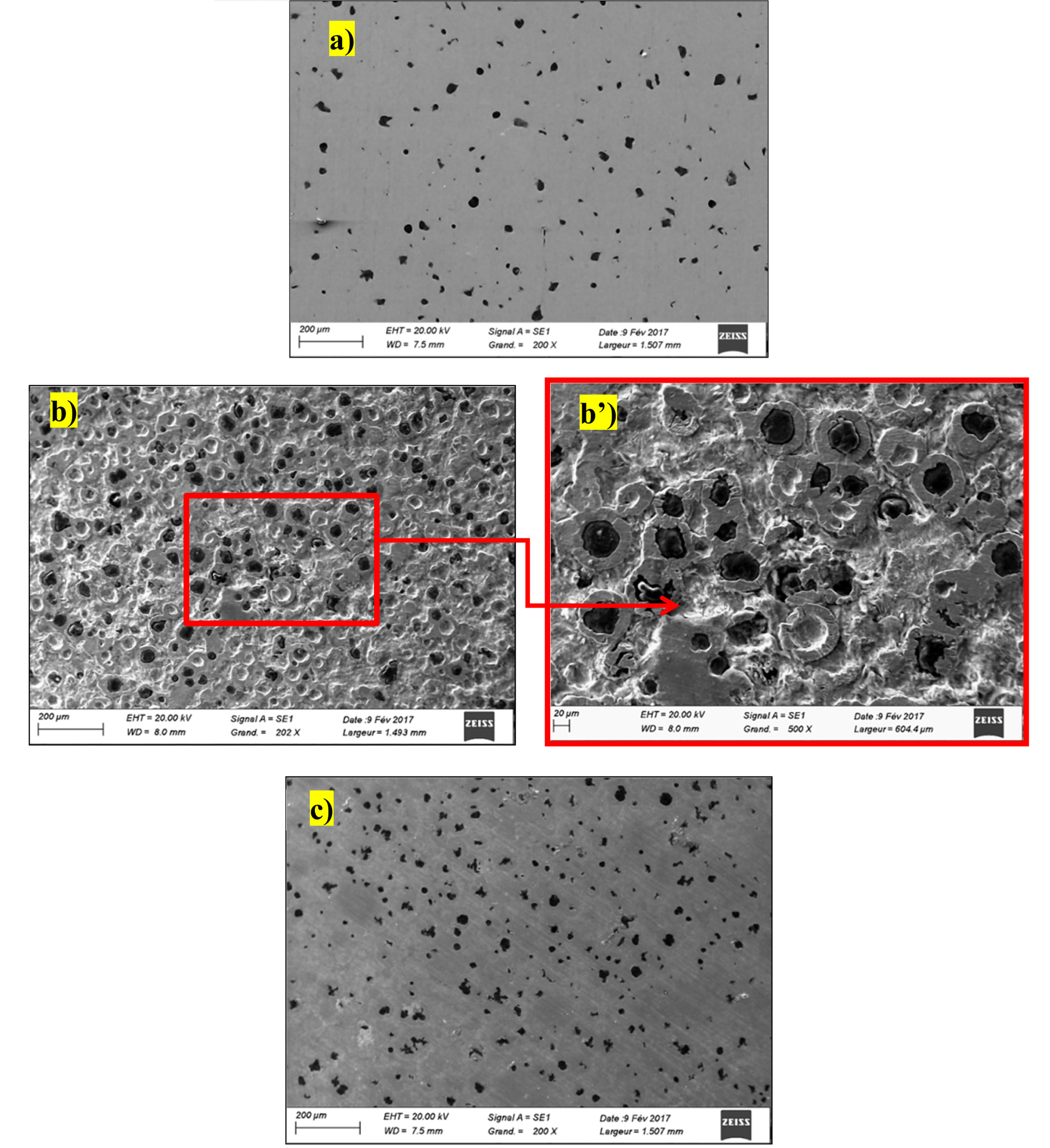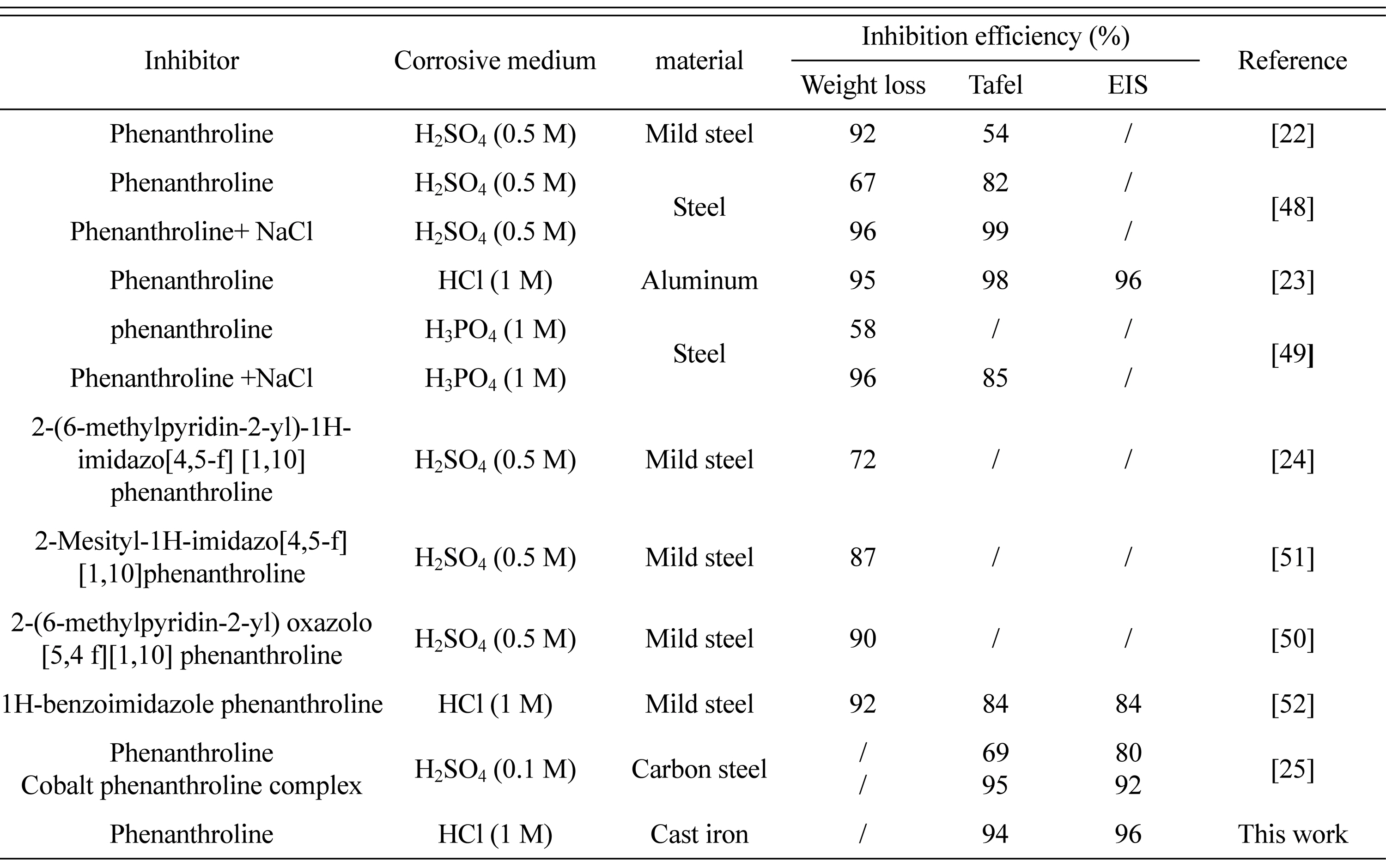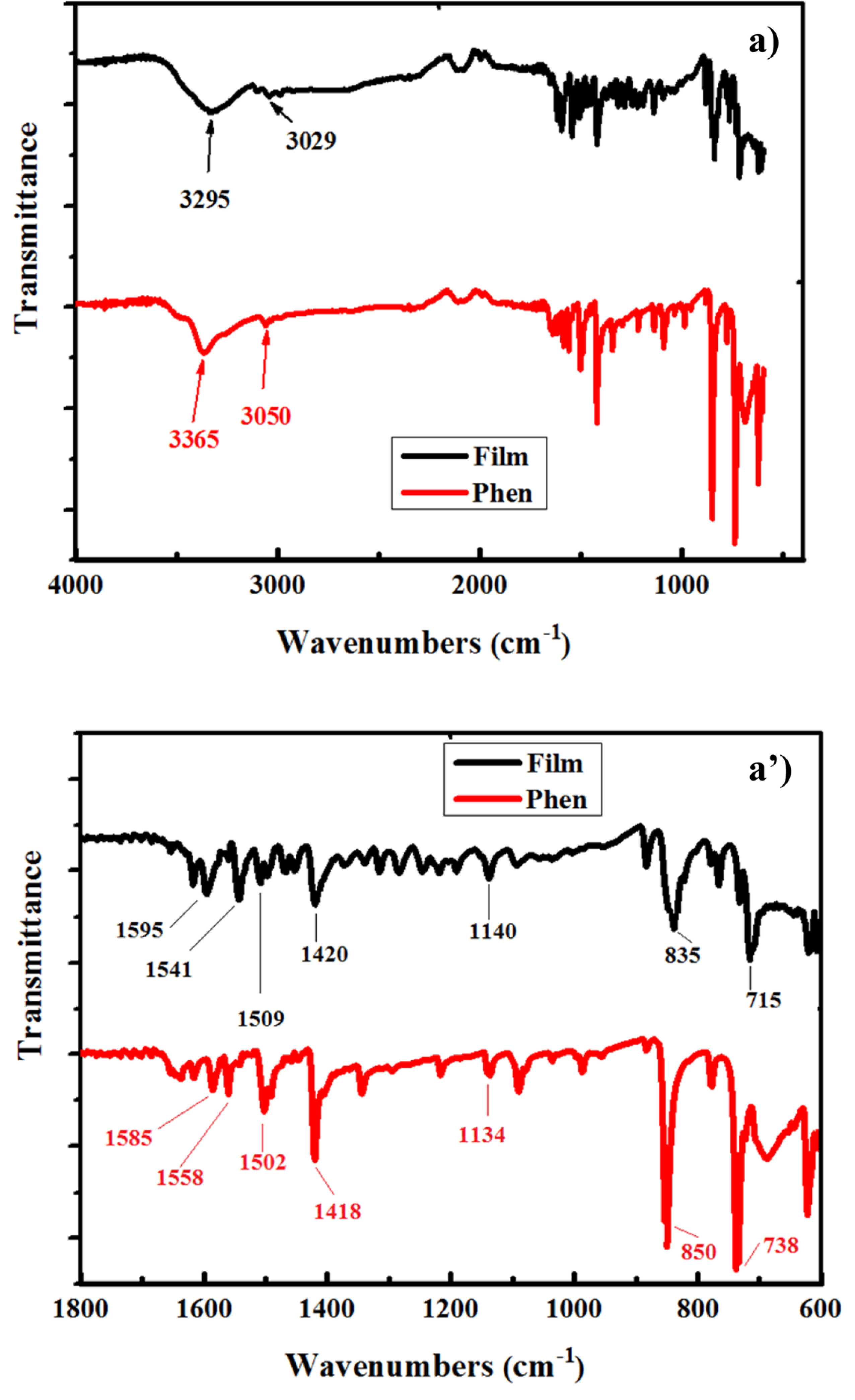[1] J. Olofsson and I. Svensson,
Mater Des,
2013,
43, 264ŌĆō271.

[2] M. Górny and E. Tyrała,
J Mater Eng Perform,
2013,
22(
1), 300ŌĆō305.

[3] K. F. Nilsson, D. Blagoeva and P. Moretto,
Eng Fract Mech,
2006,
73(
9), 1133ŌĆō1157.

[4] G.F. Geier, W. Bauer, B.J. McKay and P. Schumacher, Mater Sci Eng A, 2005, 413, 339ŌĆō345.
[5] S. Kim, S.L. Cockcroft and A.M. Omran,
J Alloys Compd,
2009,
476(
1-2), 728ŌĆō732.

[6] M. Wess├®n, I.L. Svensson and R. Aagaard,
Int J Cast Met Res,
2003,
16(
1-3), 119ŌĆō124.

[7] S.K. Putatunda,
Mater Manuf Process,
2010,
25(
8), 749ŌĆō757.

[8] A.H. El-Askalany, S.I. Mostafa, K. Shalabi, A.M. Eid and S. Shaaban,
J Mol Liq,
2016,
223, 497ŌĆō508.

[9] A.Y. Musa, A.B. Mohamad, A.A.H. Kadhum, M.S. Takriff and L.T. Tien,
Corros Sci,
2011,
53(
11), 3672ŌĆō3677.

[10] E. A. Noor and A. H. Al-Moubaraki,
Mater Chem Phys,
2008,
110, 145ŌĆō154.

[11] M. Slimane, F. Kellou and S. Kellou-Tairi,
Res Chem Intermed,
2015,
41(
11), 8571ŌĆō8590.

[12] L. D. Mello and R.S. Gon├¦alves, Corros Sci, 2001, 43(3), 457ŌĆō470.
[13] M. Abdeli, N. P. Ahmadi and R. A. Khosroshahi,
J Solid State Electrochem,
2010,
14(
7), 1317ŌĆō1324.

[14] M. Abdallah, H. M. Al-Tass, B.A.A.L. Jahdaly and A. S. Fouda,
J Mol Liq,
2016,
216, 590ŌĆō597.

[15] P. Morales-Gil, M.S. Walczak, C. R. Camargo, R. A. Cottis, J.M. Romero and R. Lindsay,
Corros Sci,
2015,
101, 47ŌĆō55.

[16] Y. Yan, W. Li, L. Cai and B. Hou,
Electrochem Acta,
2008,
53(
20), 5953ŌĆō5960.

[17] M. Finsgar and J. Jackson,
Corros Sci,
2014,
86, 17ŌĆō41.

[18] M. Shabani-Nooshabadi, M. Behpour, F. S. Razavi, M. Hamadanian and V. Nejadshafiee,
RSC Adv,
2015,
5(
30), 23357ŌĆō23366.

[19] L. Bai, L. J. Feng, H. Y. Wang, Y. B. Lu, X. W. Lei and F. L. Bai,
RSC Adv,
2015,
5(
6), 4716ŌĆō4726.

[20] Y. Abboud, A. Abourriche, T. Saffaj, M. Berrada, M. Charrouf, A. Bennamara, N. Al Himidi and H. Hannache,
Mater Chem Phys,
2007,
105(
1), 1ŌĆō5.

[21] M. A. Quraishi, J. Rawat and M. Ajmal,
J Appl Electrochem,
2000,
30, 745ŌĆō751.

[22] S. N. Banerjee and S. Misra,
Corrosion,
1989,
45(
9), 780ŌĆō783.

[23] X. Li, S. Deng and X. Xie,
J Taiwan Inst Chem Eng,
2014,
45(
4), 1865ŌĆō1875.

[24] N. O. Obi-Egbedi, I. B. Obot and A. O. Eseola,
Arab J Chem,
2014,
7, 197ŌĆō207.

[25] X. Liu, P. C. Okafor, B. Jiang, H. Hu and Y. Zheng,
J Mater Eng Perform,
2015,
24(
9), 3599ŌĆō3606.

[26] F. Kellou-Kerkouche, A. Benchettara and S. Amara,
Mater Chem Phys,
2008,
110(
1), 26ŌĆō33.

[27] V. Rajeswari, P. Viswanathamurthi and D. Kesavan,
Res Chem Intermed,
2017,
43(
7), 3893ŌĆō3913.

[28] V. Rajeswari, D. Kesavan, M. Gopiraman and P. Viswanathamurthi,
Carbohydr Polym,
2013,
95, 288ŌĆō294.

[29] V. Rajeswari, D. Kesavan, M. Gopiraman and P. Viswanathamurthi,
J Surfact Deterg,
2013,
16(
4), 571ŌĆō580.

[30] V. Rajeswari, D. Kesavan, M. Gopiraman, P. Viswanathamurthi, K. Poonkuzhali and T. Palvannan,
Appl Surf Sci,
2014,
314, 537ŌĆō545.

[31] M. Chikira, Y. Tomizawa, D. Fukita, T. Sugizaki, N. Sugawara, T. Yamazaki, A. Sasano, H. Shindo, M. Palaniandavar and W. Antholine,
J Inorg Biochem,
2002,
89, 163ŌĆō173.

[32] X. Li, S. Deng, T. Lin, X. Xie and G. Du,
Corros Sci,
2017,
118, 202ŌĆō216.

[33] R. G. Parr, L. Szentpaly and S. Liu,
J Am Chem Soc,
1999,
121(
9), 1922ŌĆō1924.

[34] R. G. Pearson,
Inorg. Chem.,
1988,
27(
4), 734ŌĆō740.

[35] A. Kokalj,
Electrochim Acta,
2001,
56, 745ŌĆō755.

[36] Q. Qu, Z. Hao, L. Li, W. Bai, Y. Liu and Z. Ding,
Corros Sci,
2009,
51(
3), 569ŌĆō574.

[37] A. Ostovari, S. M. Hoseinieh, M. Peikari, S. R. Shadizadeh and S. J. Hashemi,
Corros Sci,
2009,
51(
9), 1935ŌĆō1949.

[38] A. K. Singh and M. A. Quraishi,
Corros Sci,
2010,
52(
4), 1373ŌĆō1385.

[39] E. E. Oguzie, Y. Li and F. H. Wang,
J Colloid Interf Sci,
2007,
310(
1), 90ŌĆō98.

[40] P. Bommersbach, C. A. Dumont, J. P. Millet and B. Normand,
Electrochim Acta,
2006,
51(
19), 4011ŌĆō4018.

[41] A. M. Abdel-Gaber, B. A. Abd-El-Nabey, I. M. Sidahmed, A. M. El-Zayady and M. Saadawy,
Corros Sci,
2006,
48(
9), 2765ŌĆō2779.

[42] X. Li, S. Deng and H. Fu,
Corros Sci,
2012,
62, 163ŌĆō175.

[43] B. Xu, W. Yang, Y. Liu, X. Yin, W. Gong and Y. Chen,
Corros Sci,
2014,
78, 260ŌĆō268.

[44] G. Khan, W. J. Basirun, S. N. Kazi, P. Ahmed, L. Magaji, S. M. Ahmed, G. M. Khan and M. A. Rehman,
J Colloid Interf Sci,
2017,
502, 134ŌĆō145.

[45] C H. Hsu and F. Mansfeld,
Corrosion,
2001,
57(
9), 747ŌĆō748.

[46] K. F. Khaled,
Electrochim Acta,
2008,
53(
9), 3484ŌĆō3492.

[47] S. S. Abd- El Rehim, M. A. M. Ibrahim and K.F. Khalid,
Mater Chem Phys,
2001,
70(
3), 268ŌĆō273.

[48] X. Li, L. Tang, L. Li, G. Mu and G. Liu,
Corros Sci,
2006,
48(
2), 308ŌĆō321.

[49] G.N Mu, X Li and F Li,
Mater Chem Phys,
2004,
86(
1), 59ŌĆō68.

[50] I. B. Obot, N.O Obi-Egbedi, E.E Ebenso, A.S. Afolabi and E.E. Oguzie,
Res. Chem. Intermed,
2013,
39(
5), 1927ŌĆō1948.

[51] I.B. Obot, N.O. Obi-Egbedi and AO. Eseola,
Ind. Eng. Chem. Res,
2011,
50(
4), 2098ŌĆō2110.

[52] X Lei, H Wang, Y Feng, J Zhang, X Sun, S Lai, Z Wang and S Kang,
RSC. Adv,
2015,
5(
120), 99084ŌĆō99094.

[53] H. Ashassi-Sorkhabi and D. Seifzadeh,
J. Appl. Electrochem,
2008,
38(
11), 1545ŌĆō1552.

[54] M. Yadav, S. Kumar and L. Gope,
J. Adhes. Sci. Technol,
2014,
28(
11), 1072ŌĆō1089.

[55] A. M. Badiea and K. N. Mohana,
Corros. Sci,
2009,
51(
9), 2231ŌĆō2241.

[56] M. M. Solomon, S. A. Umoren, I. I. Udosoro and A.P. Udoh,
Corros. Sci,
2010,
52(
4), 1317ŌĆō1325.

[57] A. A. El-Awady, B. A. Abd-El-Nabey and S. G. Aziz,
J. Electrochem. Soc,
1992,
139(
8), 2149ŌĆō2154.

[58] I. B. Obot, E. E. Ebenso, N. O. Obi-Egbedi, A. S. Afolabi and Z. M. Gasem,
Res. Chem. Intermed,
2012,
38(
8), 1761ŌĆō1779.

[59] M. Abdeli, N. P. Ahmadi and R. A. Khosroshahi,
J Solid State Electrochem,
2011,
15(
9), 1867ŌĆō1873.

[60] S. Nesic,
Corros. Sci,
2007,
49(
12), 4308ŌĆō4338.

[61] C. M. Goulart, A. Esteves-Souza, C.A. Martinez-Huitle, C. J. Ferreira, M. A. Medeiros and A. Echevarria,
Corros. Sci,
2013,
67, 281ŌĆō291.

[62] M. Lebrini, M. Lagren├®e, H. Vezin, M. Traisnel and F. Bentiss,
Corros Sci,
2007,
49(
5), 2254ŌĆō2269.

[63] M. Behpour, S. M. Ghoreishi, N. Soltani, M. Salavati-Niasari, M. Hamadanian and A. Gandomi,
Corros. Sci,
2008,
50(
8), 2172ŌĆō2181.

[64] X. Li, S. Deng and H. Fu,
Corros. Sci,
2012,
55, 280ŌĆō288.

[65] T. Szauer and A. Brand,
Electrochim. Acta,
1981,
26(
9), 1253ŌĆō1256.

[66] H. Hamani, T. Douadi, D. Daoud, M. Al-Noaimi, R. Rikkouh and S. Chafaa,
J. electroanal. Chem,
2017,
801, 425ŌĆō438.

[67] OL Riggs and RM Hurd,
Corrosion,
1967,
23(
8), 252ŌĆō260.

[68] G. Gece,
Corros Sci,
2008,
50(
11), 2981ŌĆō2992.

[69] S. Martinez and I. Stagljar,
J Mol Struc Theochem,
2003,
640, 167ŌĆō174.

[70] I. Lukovits, E. Kalman and F. Zucchi,
Corrosion,
2001,
57(
1), 3ŌĆō8.

[71] A. M. Al-Sabagh, N. M. Nasser, A. A. Farag, M. A. Migahed, A. M. F Eissa and T. Mahmoud,
Egypt. J. Pet,
2013,
22(
1), 101ŌĆō116.

[72] M. R. N. El-Din and E. A. Khamis,
J. Surfact. Deterg,
2014,
17(
4), 795ŌĆō805.

[73] I. B. Obot, S. Kaya, C. Kaya and B. Tuzun,
Res. Chem. Intermed,
2016,
42(
5), 4963ŌĆō4983.

[74] M. A. Hegazy,
J. Mol. Liq,
2015,
208, 227ŌĆō236.

[75] H. M. Abd El-Lateef and A. H. Tantawy,
RSC. Adv,
2016,
6(
11), 8681ŌĆō8700.

[76] L. Madkour, S. Kaya, C. Kaya and L. Guo,
J Taiwan Inst Chem E,
2016,
68, 461ŌĆō480.

[77] D.A. Thornton and G.M. Watkins,
Spectrochim. Acta A,
1991,
47(
8), 1085ŌĆō1096.

[78] A.A. Schilt and R.C Taylor,
J. Inorg. Nucl. Chem.,
1959,
9(
3-4), 211ŌĆō221.

[79] G. Vengatesh, G. Karthik and M. Sundaravadivelu,
Egypt. J. Petrol,
2017,
26(
3), 705ŌĆō719.

[80] L. Li, X. Zhang, J. Lei, J. He, S. Zhang and F Pan,
Corros Sci,
2012,
63, 82ŌĆō90.


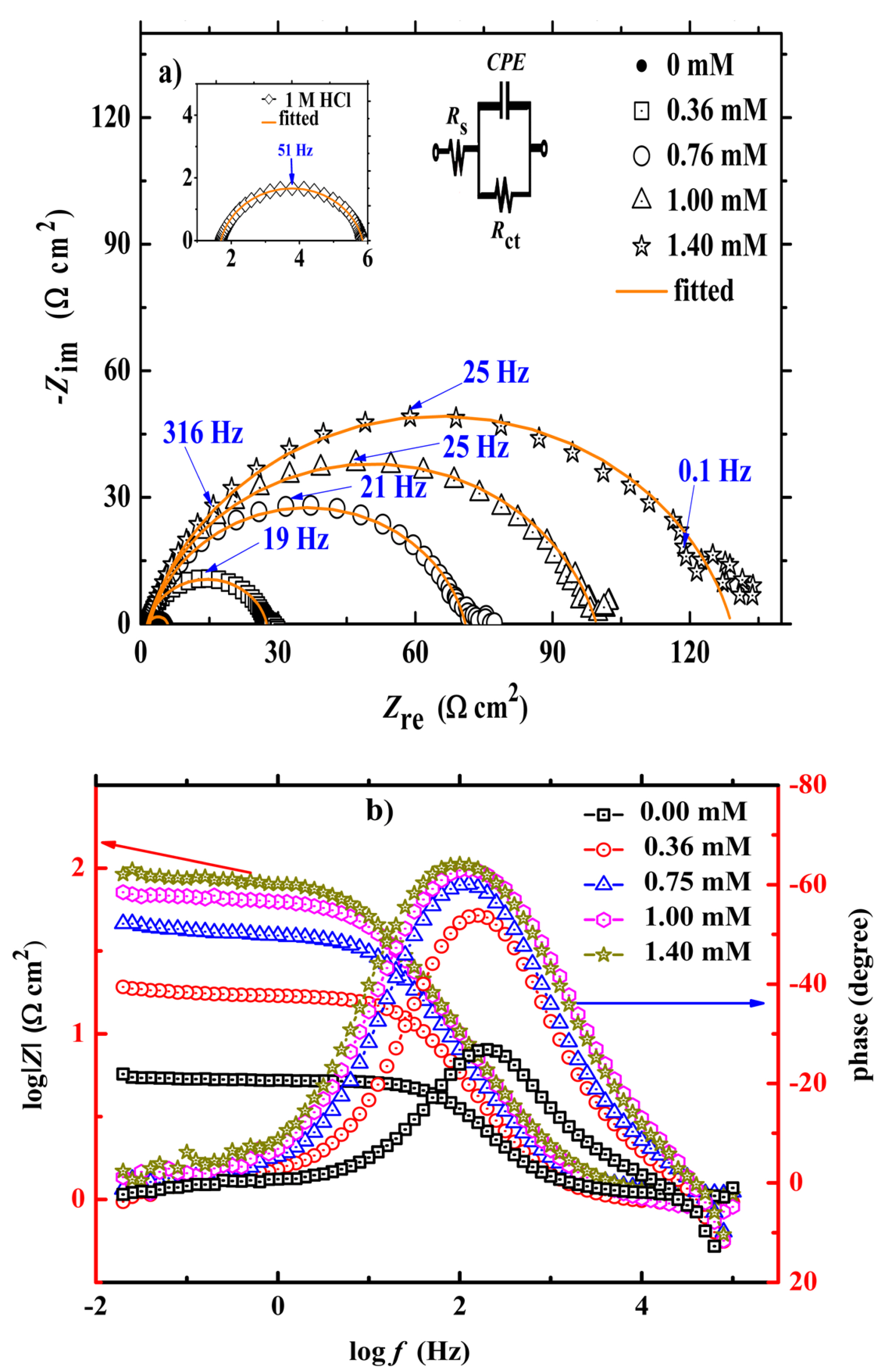
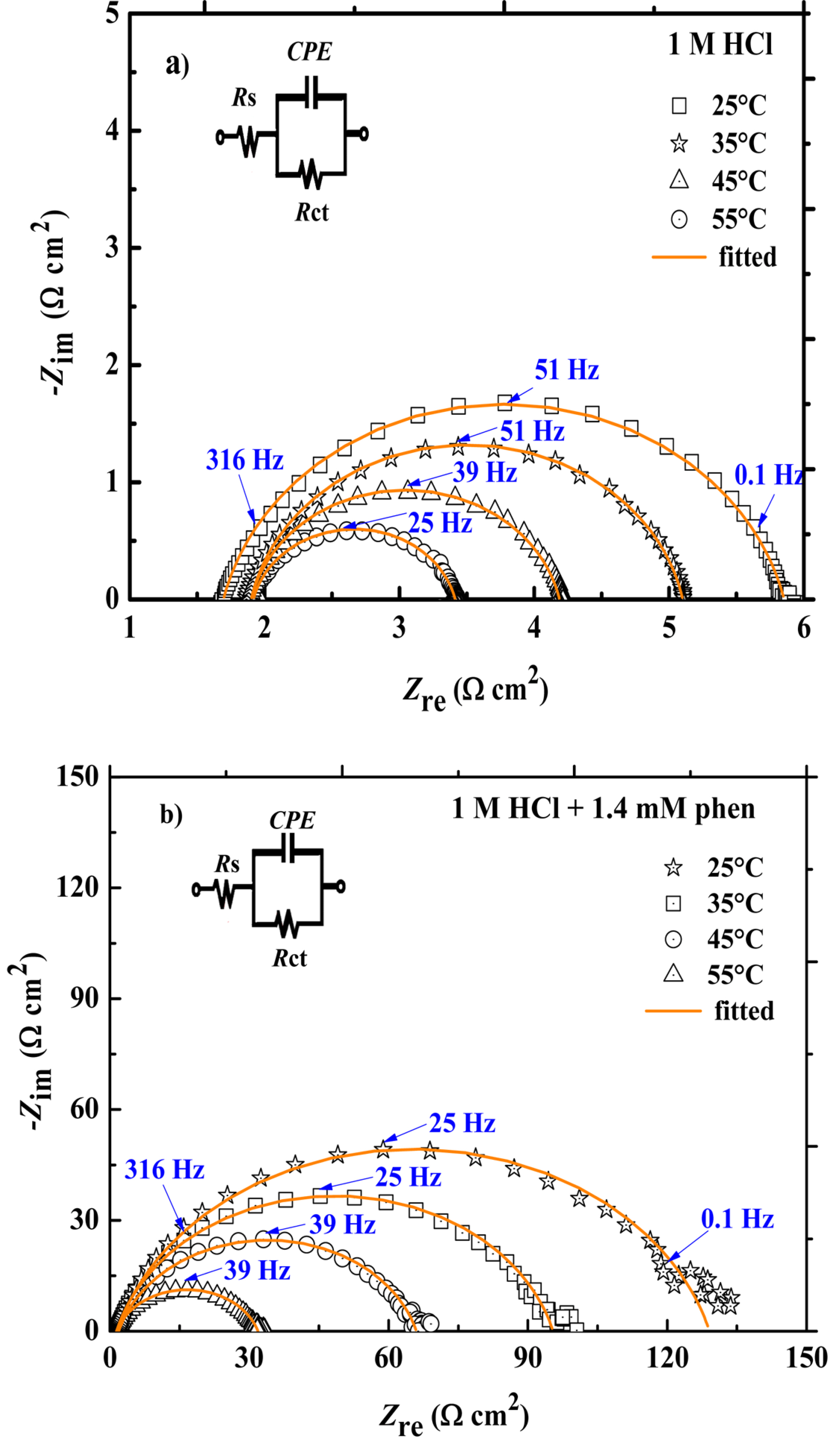
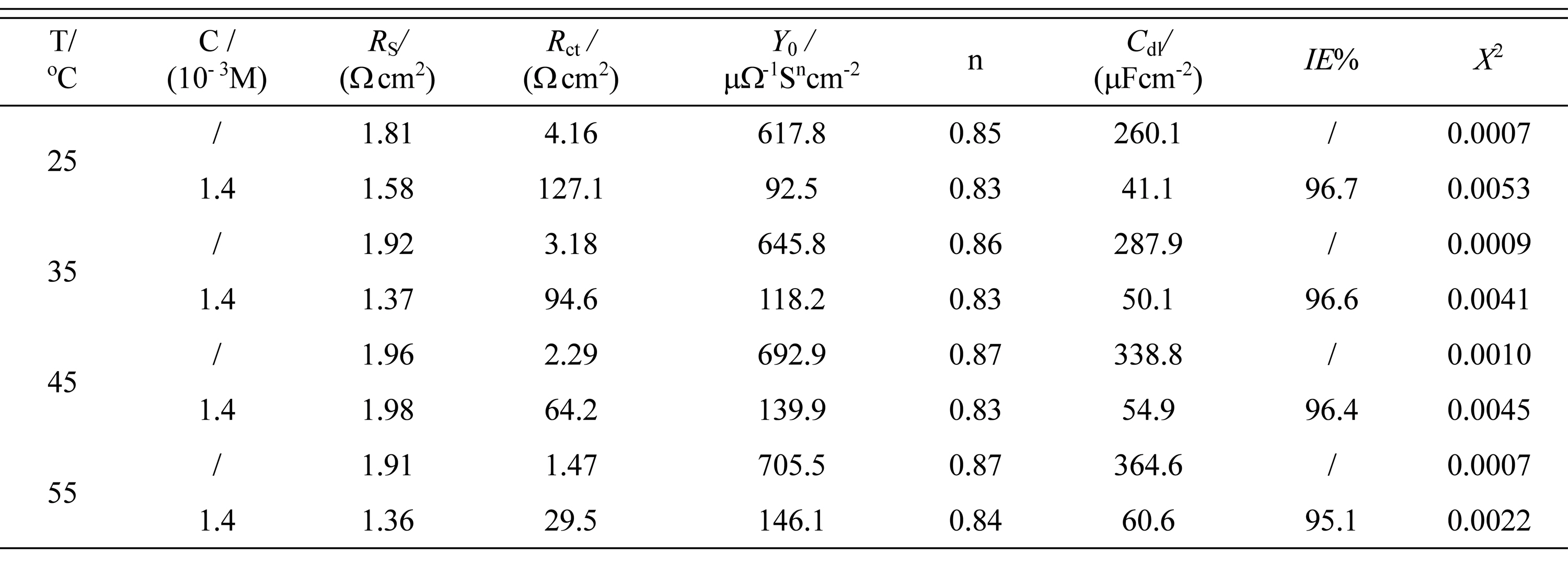
 and
and  are the enthalpy and entropy of activation, and icor (A cmŌłÆ2) represents the corrosion current densities computed from the charge transfer resistance Rct at various temperatures in the presence and absence of Phen using the following equation:
are the enthalpy and entropy of activation, and icor (A cmŌłÆ2) represents the corrosion current densities computed from the charge transfer resistance Rct at various temperatures in the presence and absence of Phen using the following equation: (Fig. 6a) corresponding to the blank and inhibitive solutions are linear throughout the temperature range, which indicates that the corrosion and corrosion inhibition processes follow the kinetics Arrhenius. The apparent activation energy values deduced from the slopes of the two straight lines are: 30.50 kJ molŌłÆ1 and 40.78 kJ molŌłÆ1 in the blank and inhibitive solution respectively. It has been reported [65-67] that inhibitors whose inhibition efficiency decreases with increasing temperature have a higher apparent activation energy value than that of the blank solution, due to physical adsorption of inhibitors on the metal surface. In the present study, the increase of the activation energy value in the presence of Phen indicates that the adsorption of Phen molecules occurs primarily through physical interactions.
(Fig. 6a) corresponding to the blank and inhibitive solutions are linear throughout the temperature range, which indicates that the corrosion and corrosion inhibition processes follow the kinetics Arrhenius. The apparent activation energy values deduced from the slopes of the two straight lines are: 30.50 kJ molŌłÆ1 and 40.78 kJ molŌłÆ1 in the blank and inhibitive solution respectively. It has been reported [65-67] that inhibitors whose inhibition efficiency decreases with increasing temperature have a higher apparent activation energy value than that of the blank solution, due to physical adsorption of inhibitors on the metal surface. In the present study, the increase of the activation energy value in the presence of Phen indicates that the adsorption of Phen molecules occurs primarily through physical interactions. ) versus
) versus  corresponding to the acidic and inhibitive solutions are linears (Fig. 6b), with a great coefficient of correlation. The slope
corresponding to the acidic and inhibitive solutions are linears (Fig. 6b), with a great coefficient of correlation. The slope  gives
gives  and the intercept ln
and the intercept ln  gives
gives  . The calculated values are gathered in Table 4.
. The calculated values are gathered in Table 4.
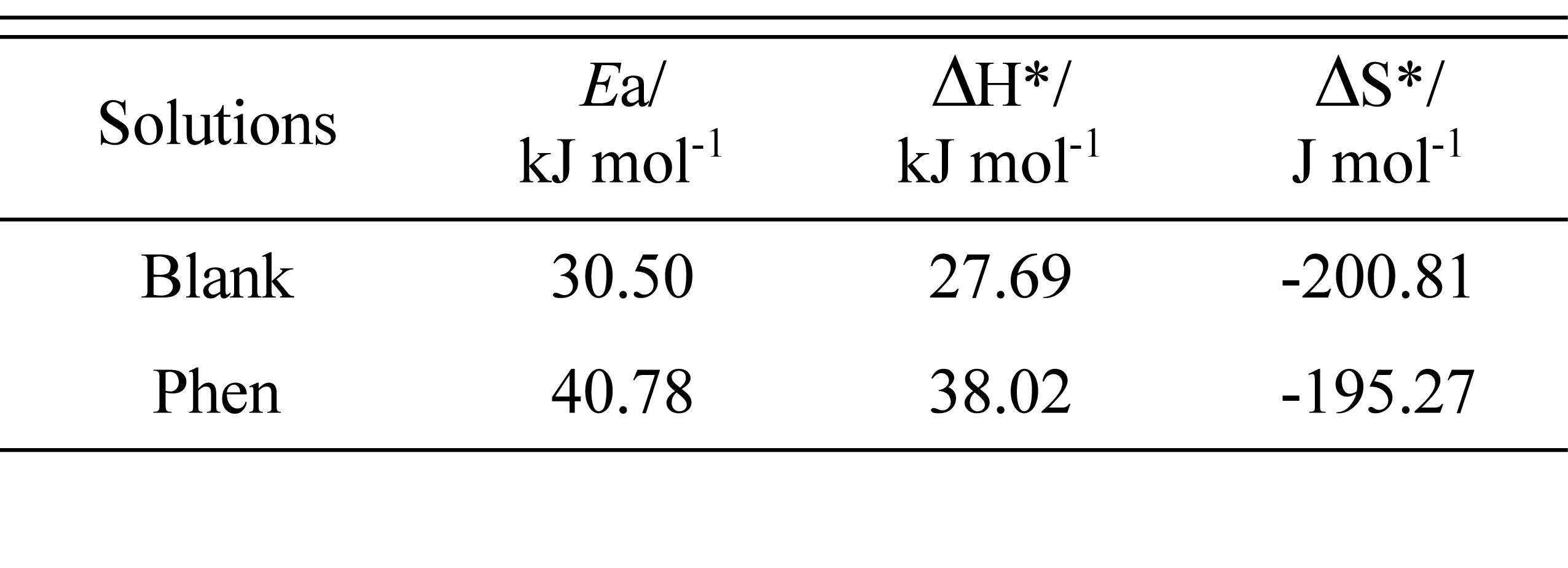
 reflected the endothermic nature of the cast iron dissolution process. The value of
reflected the endothermic nature of the cast iron dissolution process. The value of  for the uninhibited solution is lower than that for the inhibited solution. This phenomenon means a decrease in ramdomness has occurred going from reactants to the activated complex. This could be the result of the adsorption of the organic inhibitor on the electrode surface. The great negative value of entropy in the inhibited solution means that the disorder on cast iron surface decreased in the presence of Phen.
for the uninhibited solution is lower than that for the inhibited solution. This phenomenon means a decrease in ramdomness has occurred going from reactants to the activated complex. This could be the result of the adsorption of the organic inhibitor on the electrode surface. The great negative value of entropy in the inhibited solution means that the disorder on cast iron surface decreased in the presence of Phen.
 and
and  shown in Table 6, were calculated to predict the most likely atomic sites for nucleophilic and electrophilic attacks respectively. They can also explain the charge transfer as they indicate the reactive sites in the molecule. Atoms that have a high absolute
shown in Table 6, were calculated to predict the most likely atomic sites for nucleophilic and electrophilic attacks respectively. They can also explain the charge transfer as they indicate the reactive sites in the molecule. Atoms that have a high absolute  are more susceptible to nucleophilic attacks, while higher absolute
are more susceptible to nucleophilic attacks, while higher absolute  are more prone to attack by species that have electrons deficiencies.
are more prone to attack by species that have electrons deficiencies.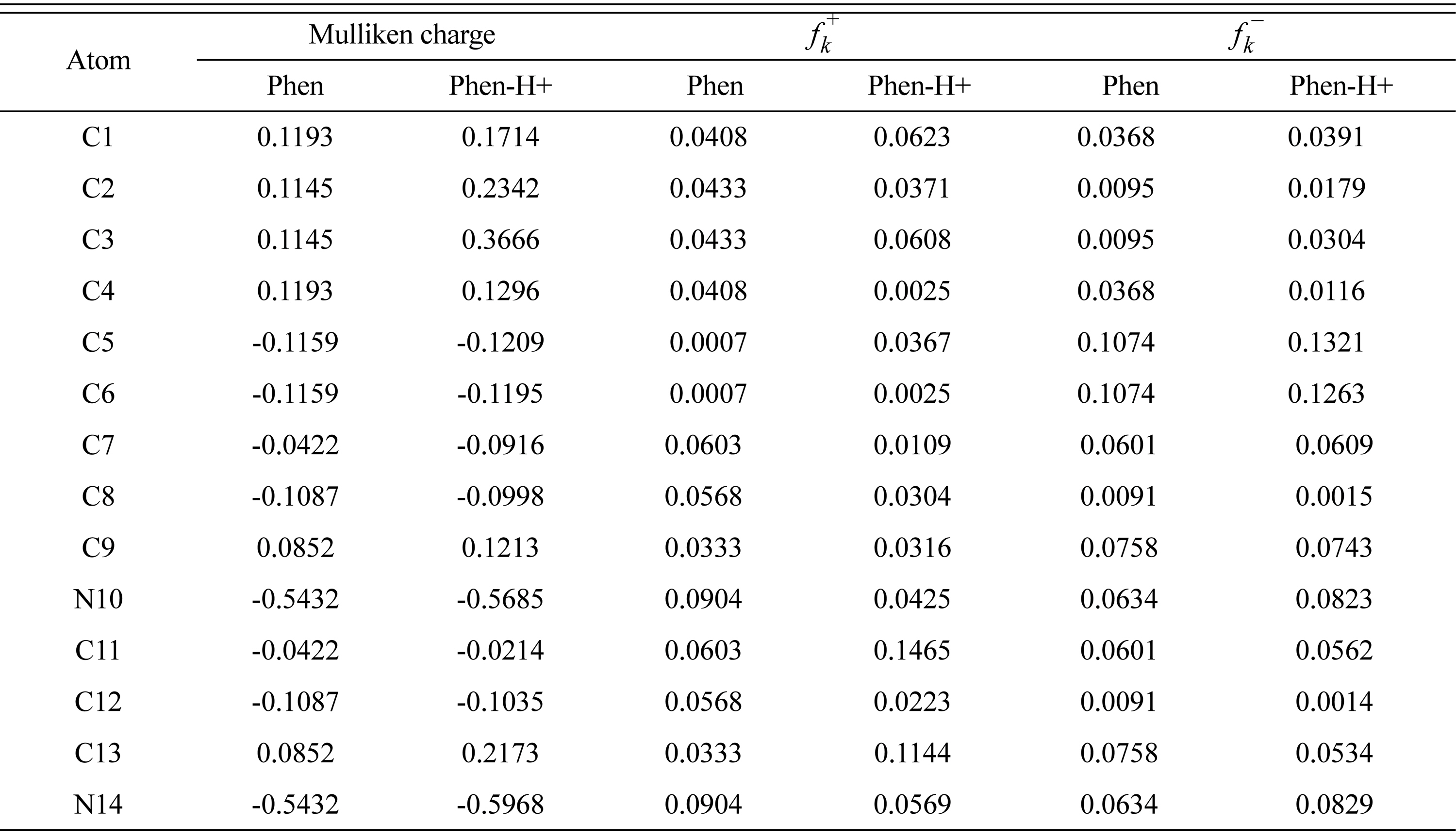
 coincide on C5 and C6 for both the neutral and protonated Phen, which may denote electrons transfer to the metal to form a coordinate bond. According to these findings, it can be suspected a likely donoracceptor interaction engaged by inhibitor molecules and iron surface. Overall, the chemical reactivity of Phen and Phen-H+ can be regarded as ŽĆ-excessive, thus the adsorption could be achieved simply by the geometric blocking effect. The theoretical study demonstrates the ability of Phen molecules to offer electrons to unoccupied d- orbital of iron, and also to accept electrons from the iron surface, which is consistent with the obtained adsorption isotherm.
coincide on C5 and C6 for both the neutral and protonated Phen, which may denote electrons transfer to the metal to form a coordinate bond. According to these findings, it can be suspected a likely donoracceptor interaction engaged by inhibitor molecules and iron surface. Overall, the chemical reactivity of Phen and Phen-H+ can be regarded as ŽĆ-excessive, thus the adsorption could be achieved simply by the geometric blocking effect. The theoretical study demonstrates the ability of Phen molecules to offer electrons to unoccupied d- orbital of iron, and also to accept electrons from the iron surface, which is consistent with the obtained adsorption isotherm.